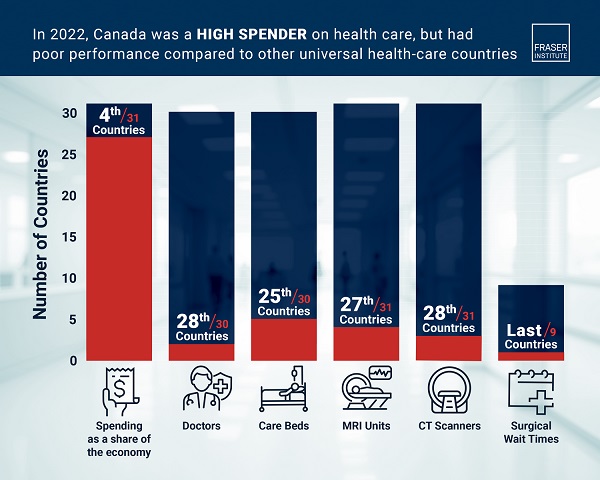Business
Canada has fewer doctors, hospital beds, MRIs and among longest wait times than other countries with universal health care

From the Fraser Institute
By Mackenzie Moir and Bacchus Barua
Among a group of 31 high-income countries that have universally accessible health care, Canada has among the lowest availability of doctors, hospital beds, and most medical technologies—and some of the longest wait times, finds a new study released today by the Fraser Institute, an independent, non-partisan Canadian public policy think-tank.
“There is a clear imbalance between the high cost of Canada’s health-care system and the value Canadians receive—particularly in terms of availability of medical resources and timely access to care,” said Bacchus Barua, director of health policy studies at the Fraser Institute and co-author of Comparing Performance of Universal Health Care
Countries, 2024.
The study compares 31 universal health-care systems in developed countries using over 40 indicators.
In 2022, using the latest year of comparable data and after adjusting for age, Canada ranked among the top third of health care spenders—4th highest for spending as a share of the economy (11.5 per cent) and 9th highest for spending per person.
Despite Canada’s high level of spending, availability and access to medical resources is generally worse than in comparable countries.
For example, Canada ranked 28th (out of 30) for the availability of doctors, 25th for hospital beds, and 25th for psychiatric beds.
That same year, Canada ranked 27th (out of 31) for the number of MRI machines available per million people, and 28th for CT scanners.
Crucially, among the nine comparable universal health-care countries that measure wait times, Canada ranks 8th (second-worst) for patients who waited more than a month to see a specialist (65.2 per cent), and the worst (9th out of 9) for patients who waited two months or more for non-emergency surgery (58.3 per cent).
“Canadians are increasingly aware of the shortcomings of their health-care system,” said Mackenzie Moir, policy analyst and co-author of the report.
“To improve health care for Canadians, policymakers should learn from other countries around the world that do universal health care better.”
- Among 31 high-income universal healthcare countries, Canada ranks among the top third of spenders but receives average to poor value in return.
- After adjusting for differences in age between countries, Canada ranked fourth highest for spending as a percentage of GDP and ninth highest for spending per person in 2022 (the most recent year of comparable data).
- Across over 40 indictors measured, Canada’s performance for availability and timely access to medical resources was generally below that of the average OECD country.
- In 2022, Canada ranked 28th (of 30) for the relative availability of doctors and 25th (of 30) for hospital beds dedicated to physical care. The same year, Canada ranked 27th (of 31) for the relative availability of Magnetic Resonance Imaging (MRI) machines, and 28th (of 31) for CT scanners.
- Canada ranked last (or close to last) on three of four indicators of timeliness of care; and ranked sixth (of nine) on the indicator measuring the percentage of patients who reported that cost was a barrier to access.
- Notably, among the nine countries that measure wait times, Canada ranked eighth worst for the percentage of patients who waited more than one month to see a specialist (65%), and reported the highest percentage of patients (58%) who waited two months or more for non-emergency surgery.
- Canada’s performance for use of resources and quality and clinical performance was mixed.
- Clearly, there is an imbalance between the value Canadians receive and the relatively high amount of money they spend on their health-care system.
Authors:
Alberta
Pierre Poilievre – Per Capita, Hardisty, Alberta Is the Most Important Little Town In Canada

From Pierre Poilievre
Business
Why it’s time to repeal the oil tanker ban on B.C.’s north coast

The Port of Prince Rupert on the north coast of British Columbia. Photo courtesy Prince Rupert Port Authority
From the Canadian Energy Centre
By Will Gibson
Moratorium does little to improve marine safety while sending the wrong message to energy investors
In 2019, Martha Hall Findlay, then-CEO of the Canada West Foundation, penned a strongly worded op-ed in the Globe and Mail calling the federal ban of oil tankers on B.C.’s northern coast “un-Canadian.”
Six years later, her opinion hasn’t changed.
“It was bad legislation and the government should get rid of it,” said Hall Findlay, now director of the University of Calgary’s School of Public Policy.
The moratorium, known as Bill C-48, banned vessels carrying more than 12,500 tonnes of oil from accessing northern B.C. ports.
Targeting products from one sector in one area does little to achieve the goal of overall improved marine transport safety, she said.
“There are risks associated with any kind of transportation with any goods, and not all of them are with oil tankers. All that singling out one part of one coast did was prevent more oil and gas from being produced that could be shipped off that coast,” she said.
Hall Findlay is a former Liberal MP who served as Suncor Energy’s chief sustainability officer before taking on her role at the University of Calgary.
She sees an opportunity to remove the tanker moratorium in light of changing attitudes about resource development across Canada and a new federal government that has publicly committed to delivering nation-building energy projects.
“There’s a greater recognition in large portions of the public across the country, not just Alberta and Saskatchewan, that Canada is too dependent on the United States as the only customer for our energy products,” she said.
“There are better alternatives to C-48, such as setting aside what are called Particularly Sensitive Sea Areas, which have been established in areas such as the Great Barrier Reef and the Galapagos Islands.”
The Business Council of British Columbia, which represents more than 200 companies, post-secondary institutions and industry associations, echoes Hall Findlay’s call for the tanker ban to be repealed.
“Comparable shipments face no such restrictions on the East Coast,” said Denise Mullen, the council’s director of environment, sustainability and Indigenous relations.
“This unfair treatment reinforces Canada’s over-reliance on the U.S. market, where Canadian oil is sold at a discount, by restricting access to Asia-Pacific markets.
“This results in billions in lost government revenues and reduced private investment at a time when our economy can least afford it.”
The ban on tanker traffic specifically in northern B.C. doesn’t make sense given Canada already has strong marine safety regulations in place, Mullen said.
Notably, completion of the Trans Mountain Pipeline expansion in 2024 also doubled marine spill response capacity on Canada’s West Coast. A $170 million investment added new equipment, personnel and response bases in the Salish Sea.
“The [C-48] moratorium adds little real protection while sending a damaging message to global investors,” she said.
“This undermines the confidence needed for long-term investment in critical trade-enabling infrastructure.”
Indigenous Resource Network executive director John Desjarlais senses there’s an openness to revisiting the issue for Indigenous communities.
“Sentiment has changed and evolved in the past six years,” he said.
“There are still concerns and trust that needs to be built. But there’s also a recognition that in addition to environmental impacts, [there are] consequences of not doing it in terms of an economic impact as well as the cascading socio-economic impacts.”
The ban effectively killed the proposed $16-billion Eagle Spirit project, an Indigenous-led pipeline that would have shipped oil from northern Alberta to a tidewater export terminal at Prince Rupert, B.C.
“When you have Indigenous participants who want to advance these projects, the moratorium needs to be revisited,” Desjarlais said.
He notes that in the six years since the tanker ban went into effect, there are growing partnerships between B.C. First Nations and the energy industry, including the Haisla Nation’s Cedar LNG project and the Nisga’a Nation’s Ksi Lisims LNG project.
This has deepened the trust that projects can mitigate risks while providing economic reconciliation and benefits to communities, Dejarlais said.
“Industry has come leaps and bounds in terms of working with First Nations,” he said.
“They are treating the rights of the communities they work with appropriately in terms of project risk and returns.”
Hall Findlay is cautiously optimistic that the tanker ban will be replaced by more appropriate legislation.
“I’m hoping that we see the revival of a federal government that brings pragmatism to governing the country,” she said.
“Repealing C-48 would be a sign of that happening.”
-

 Crime2 days ago
Crime2 days agoNational Health Care Fraud Takedown Results in 324 Defendants Charged in Connection with Over $14.6 Billion in Alleged Fraud
-

 Health2 days ago
Health2 days agoRFK Jr. Unloads Disturbing Vaccine Secrets on Tucker—And Surprises Everyone on Trump
-

 Business1 day ago
Business1 day agoElon Musk slams Trump’s ‘Big Beautiful Bill,’ calls for new political party
-

 International23 hours ago
International23 hours agoCBS settles with Trump over doctored 60 Minutes Harris interview
-

 Business15 hours ago
Business15 hours agoLatest shakedown attempt by Canada Post underscores need for privatization
-

 Business15 hours ago
Business15 hours agoWhy it’s time to repeal the oil tanker ban on B.C.’s north coast
-

 Censorship Industrial Complex1 day ago
Censorship Industrial Complex1 day agoGlobal media alliance colluded with foreign nations to crush free speech in America: House report
-

 Energy15 hours ago
Energy15 hours agoIf Canada Wants to be the World’s Energy Partner, We Need to Act Like It








